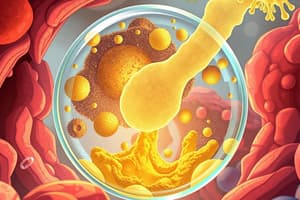Podcast
Questions and Answers
What role do coliform bacteria play as an indicator species in assessing fecal contamination?
What role do coliform bacteria play as an indicator species in assessing fecal contamination?
Coliform bacteria indicate fecal contamination as they are commonly found in the intestines of humans and animals but do not typically grow in nature without such contamination.
Explain how pasteurization impacts the microbial load in food products like milk.
Explain how pasteurization impacts the microbial load in food products like milk.
Pasteurization reduces microbial loads in foods by heating them to a temperature that kills harmful bacteria without significantly affecting the food's quality.
Describe the significance of storing milk at 4 degrees Celsius.
Describe the significance of storing milk at 4 degrees Celsius.
Storing milk at 4 degrees Celsius is critical as it slows bacterial growth, thereby preventing the spoilage and potential health risks associated with pathogenic bacteria.
Identify the most common foodborne infection linked to poultry and its causative agent.
Identify the most common foodborne infection linked to poultry and its causative agent.
How can fruits and vegetables become contaminated before reaching consumers?
How can fruits and vegetables become contaminated before reaching consumers?
What is the main process involved in the Standard Plate Count method for determining bacterial load?
What is the main process involved in the Standard Plate Count method for determining bacterial load?
Explain how serial dilution aids in estimating bacterial concentrations in food products.
Explain how serial dilution aids in estimating bacterial concentrations in food products.
Why might the Standard Plate Count method be considered inaccurate?
Why might the Standard Plate Count method be considered inaccurate?
What is the effect of Ultra High Temperature (UHT) pasteurization on food products?
What is the effect of Ultra High Temperature (UHT) pasteurization on food products?
How do contamination routes in the food supply chain vary among different food types?
How do contamination routes in the food supply chain vary among different food types?
Flashcards
Coliform bacteria
Coliform bacteria
Gram-negative, non-spore-forming bacteria that ferment lactose, producing acid and gas. Often found in the intestines of humans and animals.
Fecal coliforms
Fecal coliforms
Coliforms found in high levels in human and animal intestines. They are an indicator of fecal contamination.
Pasteurization
Pasteurization
A process used to reduce microbial loads to acceptable levels in food, such as milk and fruit juices.
UHT Pasteurization
UHT Pasteurization
Signup and view all the flashcards
Salmonella
Salmonella
Signup and view all the flashcards
Standard Plate Count
Standard Plate Count
Signup and view all the flashcards
Colony Forming Units (CFU)
Colony Forming Units (CFU)
Signup and view all the flashcards
Serial Dilution
Serial Dilution
Signup and view all the flashcards
Milk Storage
Milk Storage
Signup and view all the flashcards
Food Contamination
Food Contamination
Signup and view all the flashcards
Study Notes
Coliform Bacteria
- Gram-negative bacteria
- Do not form spores
- Ferment lactose, producing acid and gas
- Fecal coliforms are found in high concentrations in human and animal intestines
- Indicator species; rarely found in nature without fecal contamination (e.g., E. coli)
Milk
- Pasteurization reduces microbial loads in milk and fruit juices to acceptable levels
- Ultra-High Temperature (UHT) pasteurization sterilizes food if done aseptically
- Store milk at 4 degrees Celsius to prevent bacterial growth
Chicken
- Salmonella is a common foodborne illness linked to contaminated poultry
Fruits and Vegetables
- Contamination can occur from soil or water during growth
- Processing, storage, and preparation can also introduce contamination
Determining Bacterial Levels in Food
- Standard Plate Count
- Serial dilutions of the food are plated on growth media
- Bacterial colonies (CFU) are counted
- CFU (colony-forming units) – one colony may result from multiple bacteria
- Serial Dilution
- Creates very dilute solutions without precise measurements for small liquid quantities
- A series of dilutions are performed (e.g., diluting a solution, then diluting the dilution, etc.)
- If a 0.1 sample is plated, multiply CFU by 10 to calculate CFU/ml.
- If a 0.05 sample is plated, multiply CFU by 20 to calculate CFU/ml.
- Average results from multiple dilutions to determine final bacteria count/ml.
Studying That Suits You
Use AI to generate personalized quizzes and flashcards to suit your learning preferences.




